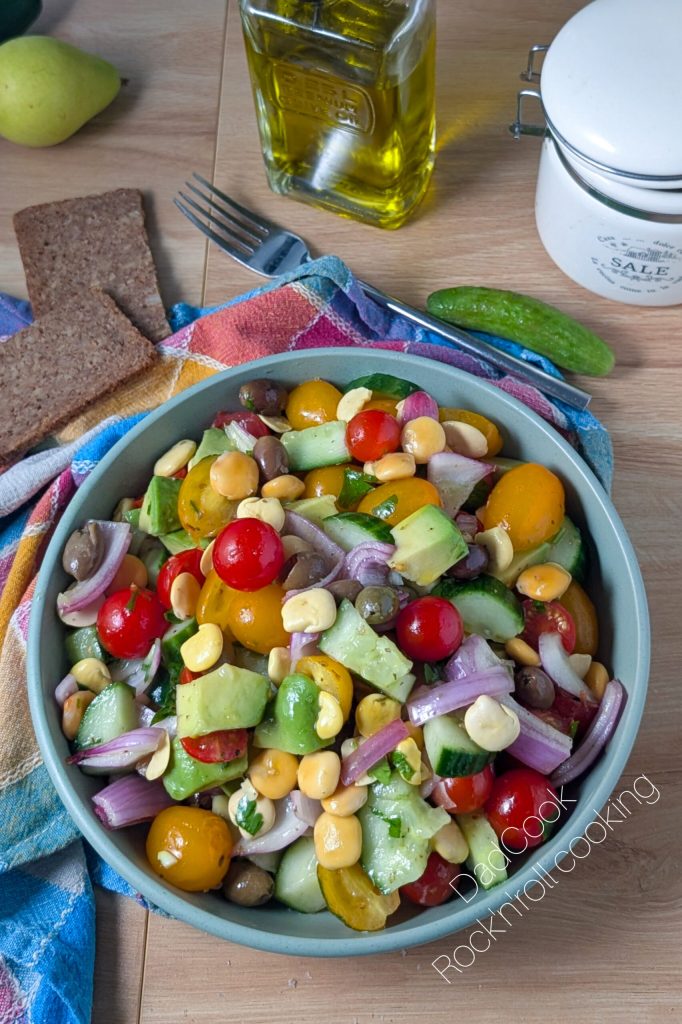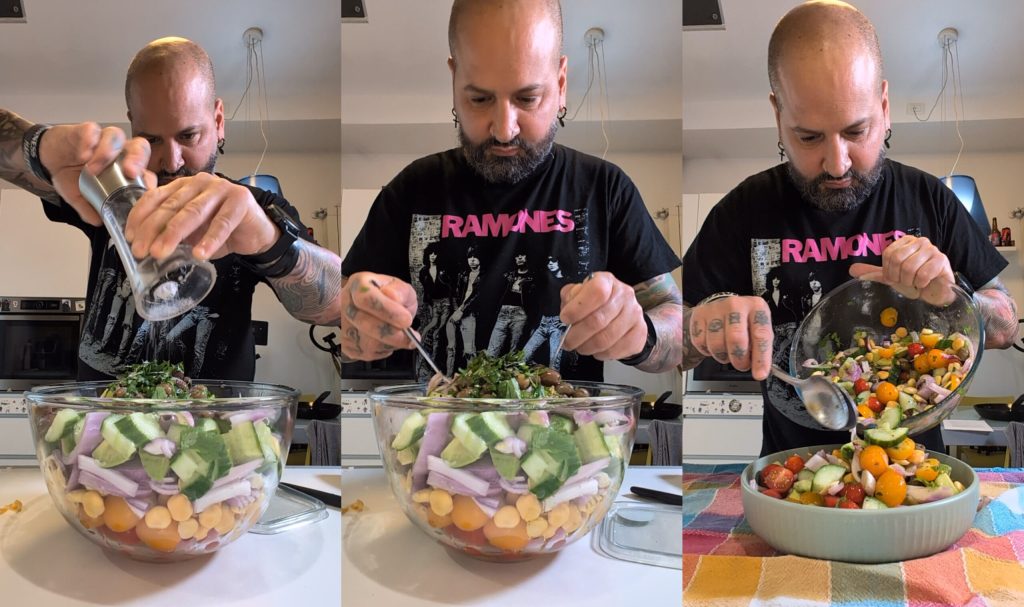Discover how to transform lupini beans in brine, a simple and ready-to-use ingredient, into a delicious, nutritious, and rich dish with the addition of avocado, thanks to this recipe for Mediterranean Salad with Lupini and Avocado.
If you’re looking for an easy and quick way to enjoy this versatile legume in a complete salad, you’re in the right place.
This fresh salad is perfect for summer, as a tasty side dish or as a light and healthy main course.
Taking advantage of the practicality of already cooked lupini beans in brine and adding the creaminess of avocado, you can serve a delicious dish in just a few minutes.
Follow the steps to create a colorful and flavorful salad!

- Difficulty: Very easy
- Cost: Very economical
- Rest time: 10 Minutes
- Preparation time: 10 Minutes
- Portions: 4
- Cooking methods: No cooking
- Cuisine: Italian
- Seasonality: Fall, Winter and Spring, All seasons
- Energy 268.78 (Kcal)
- Carbohydrates 31.34 (g) of which sugars 7.68 (g)
- Proteins 18.32 (g)
- Fat 9.91 (g) of which saturated 1.27 (g)of which unsaturated 7.14 (g)
- Fibers 11.81 (g)
- Sodium 461.32 (mg)
Indicative values for a portion of 390 g processed in an automated way starting from the nutritional information available on the CREA* and FoodData Central** databases. It is not food and / or nutritional advice.
* CREATES Food and Nutrition Research Center: https://www.crea.gov.it/alimenti-e-nutrizione https://www.alimentinutrizione.it ** U.S. Department of Agriculture, Agricultural Research Service. FoodData Central, 2019. https://fdc.nal.usda.gov
Ingredients
Recipe:
- 8.8 oz lupini
- 1 avocado
- 5.3 oz yellow cherry tomatoes
- 5.3 oz cherry tomatoes
- 1 cucumber (Long)
- 1 red Tropea onion
- 1 handful Taggiasca olives (Pitted)
- 1 bunch parsley
- 1 lemon juice
- 1 tsp oregano
- 1 pinch black pepper
- to taste salt
Tools
- 1 Bowl Pyrex
- 1 Knife Tescoma
- 1 Vegetable Cutter Freshmagis
Steps
Preparation of Lupini (Essential!): Drain the lupini beans from their brine.
Rinse them thoroughly under cold running water for several minutes.
This step is crucial to remove excess salt.
I recommend tasting one to check it’s not too salty; if necessary, soak them in fresh water for 10-15 minutes, then rinse again.
Once ready, drain them well.
To remove the skin, simply apply gentle pressure between your fingers: you will see the lupini pop out easily.
If you prefer a more rustic touch or for convenience, you can also decide to leave the skin on some lupini; it’s a matter of personal taste and they are delicious both ways!

Prepare the Vegetables: Wash the cherry tomatoes, cucumber, and red onion thoroughly.
Cut the cherry tomatoes and onion as preferred (or as indicated in the ingredients list).
For the cucumber, here’s a little secret to make it tastier and crunchier: after washing and trimming (you can leave the peel, especially if thin or organic), place it on a cutting board.
Before cutting, gently smash it along its length using the flat side of a wide knife, a meat tenderizer, or even the bottom of a sturdy jar.
You don’t need to destroy it, just create small cracks.
This method, inspired by Asian techniques, will make it more tender, less watery, and wonderfully absorb the dressing.
Once smashed, cut it into chunks or irregular pieces.
Finally, finely chop the fresh parsley.

Create the Salad Base: In a large bowl, combine the lupini beans (already well rinsed and drained), cherry tomatoes, cucumber, sliced onion, and olives.
Separately, make a quick emulsion by mixing extra virgin olive oil with fresh lemon juice and a grind of black pepper; if you like, add a bit of dried oregano too.
Pour this dressing over the salad, add the chopped fresh parsley, and give it a gentle first mix.
Just before serving, dice the avocado and add it directly to the bowl.Mix one last time very gently to avoid mashing the avocado.
Taste and, only if strictly necessary (remember lupini and olives are already salty!), adjust the salt.
Add another grind of pepper, if desired, and your salad is ready to be served!

Serving: Serve the Mediterranean salad with lupini and avocado fresh, as an appetizer, side, or light main course accompanied by toasted bread.
Enjoy your meal!

STORAGE, TIPS, AND VARIATIONS:
Storage:
The ideal is to consume this salad immediately after preparation, especially because of the avocado that tends to oxidize and change texture.
If it remains: Store it in the refrigerator in an airtight container. To minimize avocado oxidation, try covering the surface of the salad with plastic wrap in direct contact, before sealing the container. Consume it preferably within 24 hours. Keep in mind that the freshness and crunchiness of the vegetables might slightly decrease.
To prepare it in advance: You can prepare all the cut ingredients (except the avocado) and store them in separate containers in the refrigerator. Also, prepare the dressing and store it separately. Combine everything and add the avocado (cut at the moment) only just before serving.
Useful Tips:
Quality Ingredients: The simplicity of this salad highlights the flavor of the individual ingredients. Choose fresh, seasonal vegetables. If possible, prioritize Italian products such as Sicilian avocado (available roughly from late fall to spring), Tropea IGP onion, Taggiasca olives, and an excellent Italian extra virgin olive oil.
Lupini Without Secrets: Remember that thorough and prolonged rinsing of lupini beans is fundamental for removing excess brine salt. Don’t skip this step! Perfect Avocado: Add the avocado only at the last moment to prevent it from darkening. Once cut, you can sprinkle it with a bit of lemon juice (the same you’ll use for the dressing) to preserve its color.
The Cucumber Trick: The technique of “smashing” the cucumber before cutting is a great way to make it tastier, help it lose some water, and allow it to absorb the flavors of the dressing better.
Balance the Flavors: Always taste the salad before serving. You might need another pinch of salt (but with caution, considering the saltiness of lupini and olives!), another grind of pepper, or a few drops of lemon.
Milder Onion: If the taste of raw red onion seems too intense, you can soak it in cold water (maybe with a teaspoon of vinegar) for 15-20 minutes, then drain it and dry it well before adding it to the salad.
Variations on the Theme:
Additional Proteins: For a richer main course, you can add crumbled Greek feta, buffalo mozzarella bites, boiled chickpeas, good quality tuna in oil (well drained), or even smoked salmon pieces.
Crunchy Touches: Enhance it with a handful of sunflower seeds, toasted pumpkin seeds, lightly toasted pine nuts, or coarsely chopped walnuts.
Other Vegetables: Experiment with colorful bell peppers (yellow, red) cut into thin strips, steamed sweet corn, artichoke hearts in oil (well drained and sliced), or sliced radishes for a spicy note.
Mediterranean Aromas: Try adding desalinated capers, a few fresh mint leaves (especially in summer!), or hand-torn basil.
A Pinch of Spice: A hint of chili powder or fresh chili (if you like it spicy) in the dressing can give an energetic kick.
Cereal Base: To turn it into a complete meal, serve it on a bed of cooked and cooled couscous, quinoa, farro, or barley.
Cereal Base: To turn it into a complete meal, serve it on a bed of cooked and cooled couscous, quinoa, farro, or barley.

FAQ (Questions and Answers)
Frequently Asked Questions (FAQ):
Do I have to remove the skin from the lupini beans?
No, it is not obligatory, the skin is edible. Removing it makes the lupini beans more tender and with a slightly milder flavor, but leaving it (especially on some) can add a more rustic note and speed up the preparation. It’s a matter of personal taste and time available!

How can I prevent the avocado from turning black in the salad?
The main trick is to add the avocado only at the last moment, just before dressing and serving the salad. As soon as it’s cut, you can also drizzle the avocado cubes with some of the lemon juice meant for the dressing: the acidity helps to slow down the oxidation process.

Can I prepare this salad in advance?
For optimal results, especially for the freshness of the avocado and the crunchiness of the vegetables, it is best consumed right away. However, you can prepare the pre-cut vegetables (excluding the avocado) in advance and store them in separate containers in the refrigerator. The dressing can also be prepared ahead. Assemble everything and add the avocado (cut at the moment) just before serving.

Is the ‘smashing’ of the cucumber really necessary? What difference does it make?
It is not strictly necessary, you could simply slice or cube the cucumber. However, this technique (inspired by Asian cuisine) of gently smashing the cucumber before cutting it into irregular pieces creates small cracks in the flesh. This helps it absorb the dressing much better, resulting in a more flavorful experience, and gives it a more interesting, often less watery texture. It’s a small trick that, in my opinion, is worth trying!
What can I use if I can’t find Taggiasca olives or Tropea onion?
Certainly! If you don’t have Taggiasca olives, you can substitute with other good quality black olives (such as pitted Kalamata) or even flavorful green olives. For Tropea onion, a finely sliced fresh spring onion or a chopped sweet white onion can be great substitutes, aiming to maintain some delicacy in taste.
Is this salad suitable for a vegan or gluten-free diet?
Yes, in its base version as described in the recipe (without additions like feta or parmesan), this salad is naturally vegan and gluten-free. It’s a great fresh and nutritious option for everyone!

